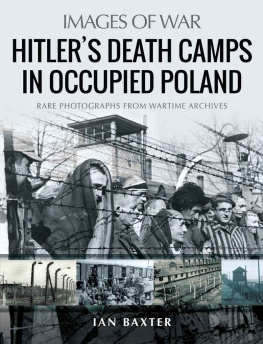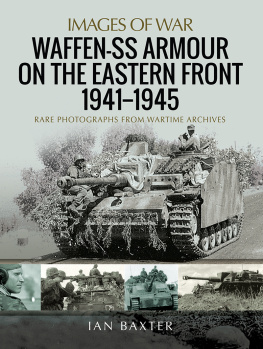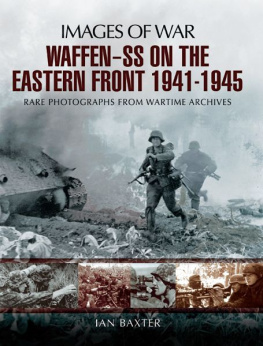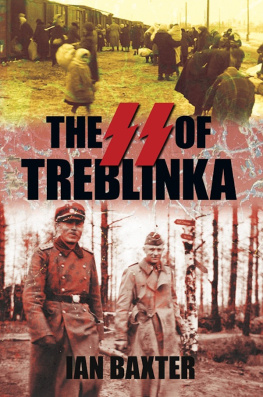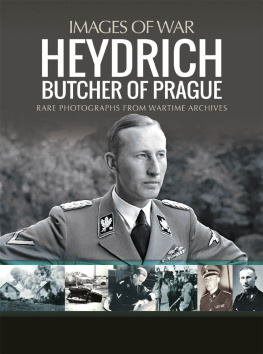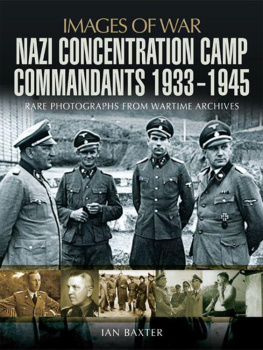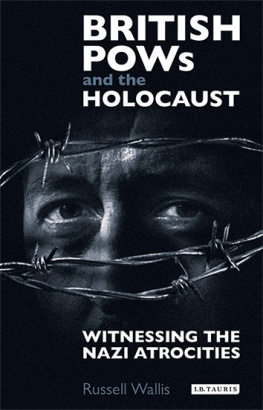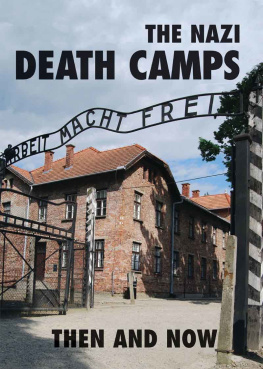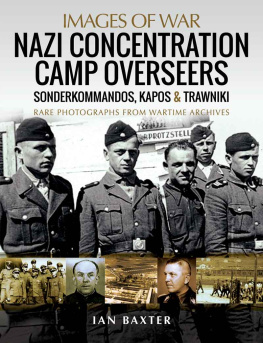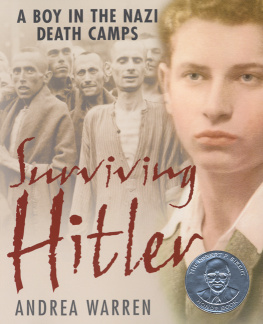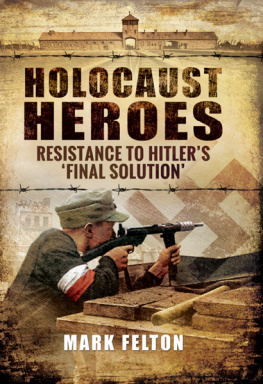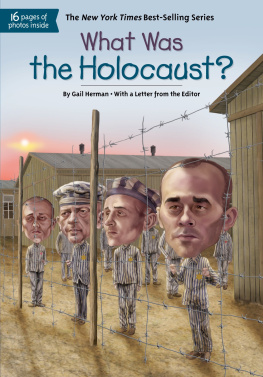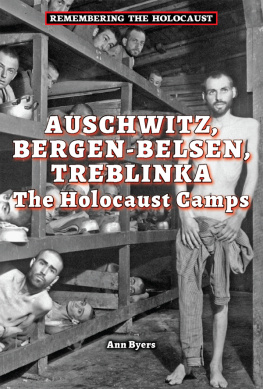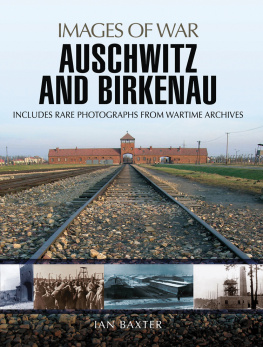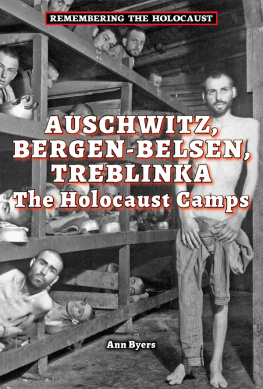Pagebreaks of the print version

IMAGESOF WAR
HITLERS
DEATH CAMPS
IN OCCUPIED
POLAND
RARE PHOTOGRAPHS FROM
WARTIME ARCHIVES
Ian Baxter
First published in Great Britain in 2021 by
PEN & SWORD MILITARY
an imprint of
Pen & Sword Books Ltd
47 Church Street
Barnsley South Yorkshire
S70 2AS
Copyright f Ian Baxter, 2021
ISBN 978-1-52676-541-3
ePUB ISBN 978-1-52676-542-0
Mobi ISBN 978-1-52676-543-7
The right of Ian Baxter to be identified as author of this work has been asserted by him in accordance with the Copyright, Designs and Patents Act 1988.
A CIP catalogue record for this book is available from the British Library.
All rights reserved. No part of this book may be reproduced or transmitted in any form or by any means, electronic or mechanical including photocopying, recording or by any information storage and retrieval system, without permission from the Publisher in writing.
Pen & Sword Books Limited incorporates the imprints of Atlas, Archaeology, Aviation, Discovery, Family History, Fiction, History, Maritime, Military, Military Classics, Politics, Select, Transport, True Crime, Air World, Frontline Publishing, Leo Cooper, Remember When, Seaforth Publishing, The Praetorian Press, Wharncliffe Local History, Wharncliffe Transport, Wharncliffe True Crime and White Owl.
For a complete list of Pen & Sword titles please contact
PEN & SWORD BOOKS LIMITED 47 Church Street, Barnsley, South Yorkshire S70 2AS, England
E-mail: enquiries@pen-and-sword.co.uk
Website: www.pen-and-sword.co.uk
About the Author
I an Baxter is a military historian who specialises in German twentieth-century military history. He has written more than fifty books including Poland The Eighteen Day Victory March, Panzers In North Africa, The Ardennes Offensive, The Western Campaign, The 12th SS Panzer-Division Hitlerjugend, The Waffen-SS on the Western Front, The Waffen-SS on the Eastern Front, The Red Army at Stalingrad, Elite German Forces of World War II, Armoured Warfare, German Tanks of War, Blitzkrieg, Panzer-Divisions at War, Hitlers Panzers, German Armoured Vehicles of World War Two, Last Two Years of the Waffen-SS at War, German Soldier Uniforms and Insignia, German Guns of the Third Reich, Defeat to Retreat: The Last Years of the German Army At War 194345, Operation Bagration the Destruction of Army Group Centre, German Guns of the Third Reich, Rommel and the Afrika Korps, U-Boat War, and most recently The Sixth Army and the Road to Stalingrad. He has written over a hundred articles including Last days of Hitler, Wolfs Lair, The Story of the V1 and V2 Rocket Programme, Secret Aircraft of World War Two, Rommel at Tobruk, Hitlers War With his Generals, Secret British Plans to Assassinate Hitler, The SS at Arnhem, Hitlerjugend, Battle of Caen 1944, Gebirgsjager at War, Panzer Crews, Hitlerjugend Guerrillas, Last Battles in the East, The Battle of Berlin, and many more. He has also reviewed numerous military studies for publication, supplied thousands of photographs and important documents to various publishers and film production companies worldwide, and lectures to various schools, colleges and universities throughout the United Kingdom and the Republic of Ireland.
Chapter One
Prelude to the Final Solution
W hen the Nazis conquered Poland at the end of September 1939, the Germans acquired territory with a population of 20 million, of whom 17 million were Poles and 675,000 Germans. Before invading, Hitler had already decided that he would clear the Poles and Jews out of the incorporated areas and replace them with German settlers. What followed was a period of unrestrained terror in Poland, particularly in the incorporated territories. The unincorporated areas, consisting of the province of Lublin and parts of the provinces of Warsaw and Krakow, contained a population of 11 million. It was initially termed the General Government of the Occupied Polish Areas and in 1940 was renamed the General Government. It became the dumping ground for all undesirables and those deemed enemies of the state. It was here that the first deportations of Poles and Jews were sent.
In early 1940 the General Government absorbed many thousands of people. Relocating Poles and Jews became an administrative nightmare and it was agreed that the Jews should be forced to live in ghettos. This would not only relieve the burden of the resettlement programme, but it was a way of temporarily getting rid of the Jewish problem. The Nazis propagated the belief that the Eastern Jews in particular were carriers of disease and needed to be isolated.
Meanwhile, the SS pursued harsh policies to deal with the threat of subversion by Polish nationalists and Jewish Bolshevists in the newly incorporated territories. By early 1940 the various detention centres of the Reich had become full to bursting due to the large numbers deemed enemies of the state. News circulated through SS channels that government officials were demanding immediate action in the expansion of the concentration camp system through its new conquered territory, Poland. The German authorities quickly pressed forward to establish camps in Poland where prisoners could be incarcerated and set to work as stonebreakers and construction workers for buildings and streets. It was envisaged that the Poles would remain as a slave labour force, and quarantine camps were established to subdue the local population.
Initially it was proposed that the quarantine camps would hold the prisoners until they were sent to concentration camps in the Reich. But it soon became apparent that this was impractical, and it was approved that these camps were to function as permanent prisons. Throughout 1940 the SS concentration camp system in Poland expanded rapidly.
While the Jews were imprisoned in ghettos, the Germans invaded the Soviet Union and the Jewish problem escalated further as thousands of Jews and other creeds regarded by the Nazis as subhuman entered the area controlled by the Reich.
Although shooting was effective as a method of killing, commanders soon became aware it had disadvantages. Firstly, the killings were difficult to conceal and were often witnessed by unauthorized persons, who often complained at the brutality.
Secondly it was distressing for the killers. Himmler was aware of the problems of mass execution. In August 1941 near Minsk he witnessed a mass killing and nearly fainted. He commented to a commander that the execution was not humane and the effects on the troops would lower morale. Meanwhile he told the army that they would have to accept the liquidations in the East as policy as it was a matter of ideology.
One idea was to get other people to do the killing: Poles, Ukrainians, Balts, and Jews who were anyway going to be killed. This was better, especially when rounding up and killing women and children. But shooting was still not a fast enough way to kill the huge numbers they wanted to kill. Himmler made it clear he required a more effective method, such as explosives or gas.
Gas was not a new method to the Nazis. A special department known as T4 had organized the euthanasia programme, which used gas to kill the insane and incurably ill. The programme was a success and run for two years, but due to public opinion it was reluctantly suspended. Now it was proposed that this method of killing should be used outside Germany against enemies of the state in the East, and plans were set in motion.

